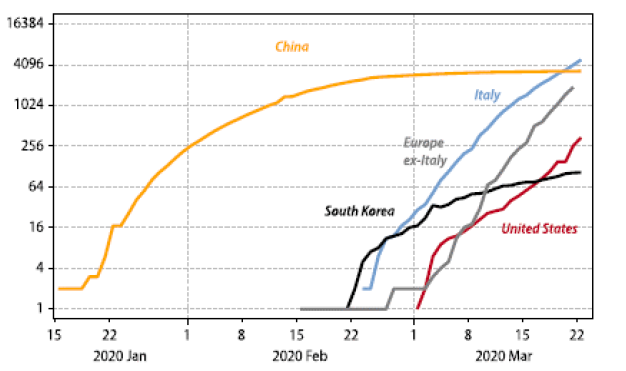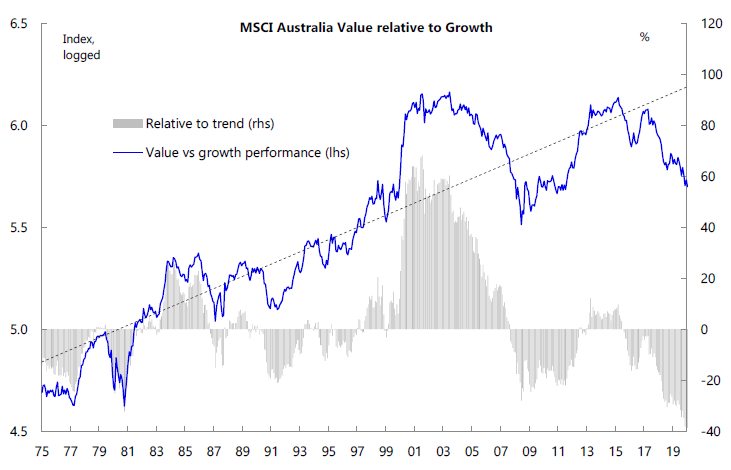The global impact of COVID-19 has been profound and governments globally are struggling to get ahead of the ultimate ramifications of the most serious respiratory virus since the 1918 H1N1 influenza pandemic (“Spanish Flu”), where according to CDC estimates, one-third of the world’s population was infected and at least 50 million people died.
The Imperial College London suggests that two fundamental courses of action are possible:
- Mitigation: focuses on slowing the epidemic and thus reducing the peak healthcare demand so the most at-risk can be protected and treated. This is the “flattening of the curve” that politicians and healthcare experts continue to talk about.
- Suppression: aims to reverse the epidemic growth, reducing numbers infected to low levels and maintaining the situation essentially until a vaccine becomes available.
The two approaches appear to differ only in the relative severity of “shutdowns” imposed. What is clear, however, is that we are not yet seeing the desired effect of shutdowns in Western economies as highlighted in Chart 1. Despite drastic, country-wide lockdowns, Italy’s fatalities continue to increase, albeit at a slowing rate of growth according to reports released by Italy’s Civil Protection agency. More alarmingly, fatalities in the US appear to be increasing at an increasing rate, suggesting that we are some time away from containment in that country. The dismissive and lackadaisical attitude of the US leadership is set to take a significant toll.
Chart 1 COVID-19 fatalities by region (log scale)

Source: Gavekal Data/Macrobond
The economic situation – How deep will the recession be?
The ongoing dramatic changes globally, as COVID-19 has spread rapidly outside China, has made estimating the economic cost, at this stage, little better than guesswork. However, there is now little doubt that the world is heading into a recession given the various levels of industry and workplace shutdowns. Large cities, such as New York, Los Angeles and San Francisco, have taken the lead from the Chinese Wuhan example and are keeping all people inside to stop the spread of COVID-19. This will have an extraordinarily negative impact on the economy. Within Australia, the government is gradually shutting down the economy and instituting social distancing, all the while keeping essential industry in place. This is a fluid situation that is literally changing by the day. Australia will more than likely move into its first recession for 30 years with many economists suggesting peak to trough declines in GDP of double digits. It is worth reflecting that it only takes 6–7 days of a complete shutdown to subtract some 10% from measured activity. In regards to the fiscal and monetary responses, we are witnessing action that is unprecedented in both scale and alignment across the globe. The total size of the US fiscal stimulus now exceeds USD 1 trillion (c. 5% of GDP) and seems to grow every day with Trump’s chief economic advisor Kudlow suggesting that a stimulus package worth USD 2 trillion was likely (equivalent to 10% of GDP). The vast majority of this stimulus is to be paid out in 2020 with direct payments into bank accounts, programs to stabilise small business, and provisions for a safety net. At the time of writing, there is some difficulty getting this passed by Congress; but hopefully common sense prevails over political grandstanding. On Sunday 22 March, the Australian government scaled-up its fiscal support to Australian dollar (AUD) 66 billion (c. 3.5% of GDP) with a second phase of policies designed to compensate for the shutdowns of non-essential businesses. The support included AUD 31.9 billion cash flow for businesses across industries covering 7.8 million workers and can only be accessed if companies do not lay off staff. The government is now guaranteeing 50% of bank loans up to AUD 40 billion. The package, combined with the banking sector’s deferral of interest payments for six months, is clearly aimed at keeping as many businesses alive as possible through this period and encouraging those same businesses to keep people employed, such that a more rapid recovery in activity is possible once the shutdown is complete. The second phase follows the AUD 17.6 billion fiscal package announced on 12 March, together with the three-pronged easing package by the Reserve Bank of Australia (RBA) on 19 March. Taken together, AUD 189 billion (c10% of GDP) of monetary and fiscal support has been announced to date. According to the Australian Treasury, they expect the cumulative policy measures will increase GDP growth by 2.75% and 3.25% in the 2nd and 3rd quarters of 2020, respectively. Importantly, the Prime Minister’s office flagged over time further policy support would be announced: “We know that there is more to do and we will continue to do what it takes.” The Hon. Josh Frydenberg, MP.
Building bridges without metal and concrete while flattening curves
The RBA wants to flatten the yield curve and the federal government and health authorities want to flatten the curve of new COVID-19 cases so the health system is not overwhelmed as it is in Italy at present. The two phases of stimulus are designed to build the bridge to a point where cases start to decline and vaccines become available.
China’s emergence from the virus
The spread of the virus in China has slowed to a trickle and the economic recovery appears to be underway with most industries returning. This implies economic growth should be strong in the 2Q given the deep hit in the 1Q, estimated to be anywhere between -1to -6% — the first time for negative GDP in modern Chinese history. The early indicators, including discussion with companies with operations within China, is that activity has been moving up since early March, with the government moving from epidemic control to economic revival. The outlook is a little clouded at present given the apparent reluctance by the government to push out large monetary and fiscal stimulus together with the risks around demand for China exports given the pending global recession. Infrastructure investment could be one of the keys for China to mitigate against the economic impact of COVID-19, making it less reliant on exports. China still has big city problems and thus investment into further high speed rail, EV charging stations, ultra-high voltage transmission lines, artificial intelligence, 5G base stations and data centres to name a few could fast track ‘smart supercities’ and thus enhance long-term productivity. This would no doubt be a positive fillip for the Australian economy, as it was during the GFC.
Risk parity, ETFs and the crazy volatility
The COVID-19 pandemic has been the catalyst for the fastest correction in many equity markets and risk since 1929. The combination of little market depth (approximately 90% decline relative to the past year average in the US), gamma hedging and systematic flows is pushing a market to regular moves of approximately 10%. The intraday volatility is staggering with +10% and -10% moves in stocks on little fundamental news. Market commentators have been lamenting the increased market risk and self-reinforcing trends that have resulted from the growth in risk parity portfolios. The spike in volatility has resulted in the equity market being hit by both deleveraging and allocation out of equity into bonds. The less negative correlation between bonds and equity has exacerbated the deleveraging of the typical bond/equity risk parity portfolio. Both JP Morgan and Morgan Stanley are of the view that we are at the end, or close to the end, of the de-risking event. Additionally, the stark underperformance of equities over bonds may see a large move in fixed-weight asset allocation portfolios. The low liquidity and compounding effect of short gamma may make the upwards correction larger than normal, as we saw in December 2018.
Spotlight on the portfolio
Although the global economy ended on a weak note in 2019, both manufacturing and services survey data were turning positive and suggesting a rebound was underway. This augured well for our overweight position in the undervalued, economically sensitive stocks. However, by mid to late January the COVID-19 situation created concerns and this was, at least, a China supply-chain and China demand issue, which we believed could soften growth expectations globally. While the market performed strongly in January, during the second half of January, the market rise was driven by defensive earning stocks as well as growth stocks; while value stocks lagged. Seeing the risks in the COVID-19 situation, in late January we decided to marginally reduce the beta/risk profile of the portfolio. We still wanted to maintain our broad positioning in undervalued stocks, but acknowledged we needed to reduce the risk in the portfolio given the unfolding COVID-19 situation. It is now clear that not only has the recovery been put on hold by the COVID-19 outbreak, it has become clear we are entering recessionary conditions as a result. The tsunami of earnings downgrades and/or removal of previous guidance due to COVID-19 has yet to let up. Consumer cyclical stocks that are directly impacted by travel bans and social distancing, such as travel, gaming and leisure, were the first to withdraw guidance. The expectation now that non-essential businesses are being shuttered will result in further downgrades. Given cash flow concerns, there will be pressure on boards to either reduce or cancel dividends for the foreseeable future.
Earnings estimates
While the rapidly developing situation and ensuing uncertainty makes forecasting more difficult, we are reassessing our earnings estimates. This includes a review of short-term earnings and implications for dividends and balance sheet risk, as well as long-term earnings, which has implications for valuations. As well as assessing the risks associated with stocks in the portfolio currently, we are also actively assessing opportunities thrown up by the aggressive and, in some instances, indiscriminate sell-off. Ultimately the impact on long-term earnings estimates and valuations will be a function of the depth, duration and damage inflicted during this period of enforced subdued activity.
Liquidity
The liquidity issues created during the GFC do not appear to be as large this time around given many boards have long memories and thus debt levels are generally low and tenure is reasonable. The short-term removal of some of the Corporation Act issues for directors around trading while insolvent and banks being encouraged to provide some relief to consumers and corporates around debt payments and covenants lessens the risks. Given the uncertainty around the duration and depth of the current downturn, we are holding on to some of our more expensive defensive positions longer than normal, such as Coles, despite the huge out performance. We have added further defensive positions such as Metcash and Telstra, both of which are unlikely to have revenue headwinds given they are both essential services.
Banks
The outlook for the banking sector has deteriorated, with two major sources of weakness. Firstly and most immediately, the deterioration in the economic backdrop and looming recession will undoubtedly result in higher bad debts. The second source of weakness is a function of our expectation that interest rates will remain “lower for longer” due to the elevated government debt that will almost certainly result from this crisis. Combined, these factors have driven a reduction in valuations and we remain underweight as a result. We note that the government, RBA and APRA have put in place an incredible amount of support for the banks. While this de-risks the banks in regard to funding or liquidity pressures, the intent behind these various initiatives is the provision of financial support to the broader economy via the maintenance of businesses and relief for consumers during this period of stress. While these measures may ultimately limit the downside exposure for banks from a bad debt perspective, they are not a source of incremental profitability.
Mining
Current events have created significant but quite diverse issues for the mining sector. Base metal prices are suffering on the weakened and uncertain global economic outlook, while bulk commodities, in particular steel-making inputs, iron ore and coking coal, have held up remarkably well. The divergence appears to be explained by China’s recovery from the COVID-19 crisis and an expectation of an infrastructure-led stimulus.
The battle between value and growth
The defensive bond-sensitive and quality names remain in “bubble” territory and would be expected to correct heavily when the market moves into more rational territory. The valuation divergence is illustrated by the gap between high and low PE names, which remains extreme and as such there is significant upside potential in the portfolio as and when market valuations normalise to more appropriate levels.
Chart 2 MSCI Australia value relative to growth

Source: Bloomberg, Deutsche Bank, Nikko AM
Chart 2 highlights this valuation divergence. It shows that since 2015, the Value Index has materially underperformed and has taken another leg down in recent months. While we don’t know when the COVID-19 situation will improve, history suggests that the market will experience a significant and aggressive recovery when greater clarity regarding the outlook is achieved. It is likely that the trigger for such a recovery in this current crisis will be a reduction in new cases.
Important Information
This material was prepared and is issued by Nikko Asset Management Australia Limited ABN 34 002 542 038, AFSL 229664 (Nikko AM Australia) who is the responsible entity and issuer of units in the Nikko AM Australian Share Wholesale Fund (NASWF) ARSN 090 089 562. Nikko AM Australia is part of the Nikko AM Group. It is for the use of researchers, licensed financial advisers and their authorised representatives. This material has been prepared without taking into account a potential investor’s objectives, financial situation or needs, and is not intended to constitute personal advice, and must not be relied upon as such. Before making a decision based on this material, a potential investor should consider the Fund’s Product Disclosure Statement (PDS) and the ‘Additional Information to the PDS’ which are available at www.nikkoam.com.au/pds. Applications will only be accepted if made on a current application form. An investment in the Fund is not a bank deposit and distributions and the return of capital are not guaranteed. Past performance is not an indicator of future performance. Whilst we believe the information contained in this material to be correct as at the date of presentation, no warranty of accuracy or reliability is given and no responsibility is accepted for errors or omissions. Any references to particular securities or sectors are for illustrative purposes only and are as at the date of publication of this material. This is not a recommendation in relation to any named securities or sectors and no warranty or guarantee is provided that the positions will remain within the portfolio of the Fund. Any economic or market forecasts are not guaranteed.
Any reference to ‘portfolio’ means the Nikko AM Australian Share Wholesale Fund.


